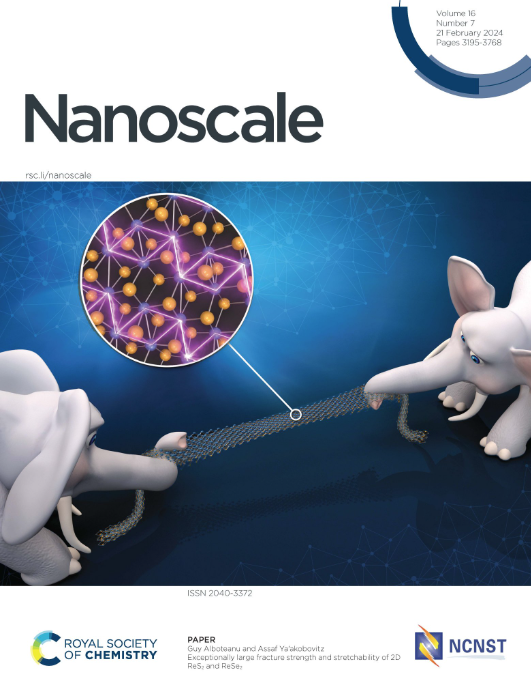2D Material-Based Memristors for Low Energy Consumption Artificial Synapses for Neuromorphic Responses
IF 5.8
3区 材料科学
Q1 CHEMISTRY, MULTIDISCIPLINARY
引用次数: 0
Abstract
The potential of two-dimensional (2D) transition metal dichalcogenides (TMDs), especially molybdenum telluride (MoTe₂), in sophisticated electrical and low-energy neuromorphic applications, has attracted a lot of interest. The creation, characteristics, and uses of MoTe₂-based memristive devices are summarized in this review paper, with an emphasis on their potential as artificial synapses for neuromorphic computing. We thoroughly examine the special properties of MoTe₂, such as its remarkable resistance switching response, excellent linearity in synaptic potentiation, and customizable phase states. These characteristics make it possible to implement basic computational functions with minimal energy consumption, including decimal arithmetic operations and the commutative principles of addition and multiplication. In addition to simulating intricate synaptic processes such as long-term potentiation (LTP), long-term depression (LTD), and spike-timing-dependent plasticity (STDP), the article emphasizes experimental performances of MoTe₂ memristors, which include their capacity to execute exact decimal arithmetic operations. The demonstration of centimeter-scale 2D MoTe₂ film-based memristor arrays attaining over 90% recognition accuracy in handwritten digit identification tests further demonstrates the devices great scalability, stability, and incorporation capabilities. Notwithstanding these developments, issues such poor environmental robustness, phase transition sensitivity, and low thermal stability still exist. The creation of hybrid or composite materials, doping, and structural alteration are some of the methods to get beyond these obstacles that are covered in the paper. The need for scalable, economical synthesis techniques and a better comprehension of the materials mechanical, optical, and electrical properties through modeling and experiments are emphasized.用于神经形态反应的低能耗人工突触的二维材料基记忆电阻器
二维(2D)过渡金属二掺杂物(TMD),尤其是碲化镉钼(MoTe₂)在复杂的电气和低能耗神经形态应用中的潜力引起了人们的极大兴趣。本文总结了基于 MoTe₂的忆阻器件的创建、特性和用途,重点介绍了它们作为神经形态计算人工突触的潜力。我们深入研究了 MoTe₂的特殊性能,例如其显著的电阻开关响应、突触电位的出色线性以及可定制的相态。这些特性使得我们能够以最小的能耗实现基本的计算功能,包括十进制算术运算以及加法和乘法的交换原理。除了模拟复杂的突触过程,如长期延时(LTP)、长期抑制(LTD)和尖峰计时可塑性(STDP),文章还强调了 MoTe₂忆阻器的实验性能,包括执行精确的十进制算术运算的能力。基于薄膜的厘米级二维 MoTe₂忆阻器阵列在手写数字识别测试中达到了 90% 以上的识别准确率,这进一步证明了该器件强大的可扩展性、稳定性和集成能力。尽管取得了这些进展,但仍存在环境鲁棒性差、相变敏感性和热稳定性低等问题。本文将介绍一些克服这些障碍的方法,如创建混合或复合材料、掺杂和改变结构等。论文强调需要可扩展、经济的合成技术,并通过建模和实验更好地理解材料的机械、光学和电学特性。
本文章由计算机程序翻译,如有差异,请以英文原文为准。
求助全文
约1分钟内获得全文
求助全文
来源期刊

Nanoscale
CHEMISTRY, MULTIDISCIPLINARY-NANOSCIENCE & NANOTECHNOLOGY
CiteScore
12.10
自引率
3.00%
发文量
1628
审稿时长
1.6 months
期刊介绍:
Nanoscale is a high-impact international journal, publishing high-quality research across nanoscience and nanotechnology. Nanoscale publishes a full mix of research articles on experimental and theoretical work, including reviews, communications, and full papers.Highly interdisciplinary, this journal appeals to scientists, researchers and professionals interested in nanoscience and nanotechnology, quantum materials and quantum technology, including the areas of physics, chemistry, biology, medicine, materials, energy/environment, information technology, detection science, healthcare and drug discovery, and electronics.
 求助内容:
求助内容: 应助结果提醒方式:
应助结果提醒方式:


